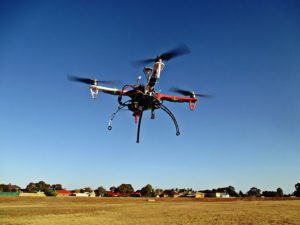While Earon was well-known as a co-founder and Chief Technology Officer (CTO) at commercial drone platform PrecisionHawk, he says that the move from CTO to EVP of Artificial Intelligence – and from hardware to insurance – was a natural one. “Moving from CTO to EVP of AI was a natural progression,” says Earon. “One of the key roles of my new position is to help evangelize the benefits of this new enabling technology and implement a vision for the future that can really drive huge benefits. Thinking back, that also would have been the job description for my role as CTO,” Earon comments. “I spend as much time helping the company craft its leadership position and ambitions in the space as I do talking with customers and partners about the art of the possible.”
The “Business-Holistic” Viewpoint
While commercial aircraft and insurance don’t seem to be very closely connected, Earon says that’s not true – they’re both a critical part of a business, and that’s what emerging industries need to focus on. “As drones move from a novel technology to an established part of a commercial workflow, the industry needs to embrace a more “business-holistic” viewpoint,” says Earon. “It’s not just about how cool of a business they are, or even how advanced and disruptive they are. It’s about how you can build the business into something that is truly viable — particularly for larger scale deployments.”
That’s where insurance comes into play. “Understanding, quantitatively, what the shape of the risk of the operations are, mitigating and protecting against those risks, and pricing all of that as an ongoing operational program are critical. Naturally, insurance is a crucial part of that. This is true for both owner-operators as well as large enterprises that use drones to drive revenue growth…We’re talking about a highly competitive space that is seeing rapid maturity.”
“You wouldn’t operate a commercial aviation outfit without insurance, but it should be available in a way that makes sense for your particular business,” says Earon.
The Significance of AI
Earon sees AI as a game-changer in the drone industry. “AI is going to be as significant in the drone industry as electric motors were,” he says. “It will change the kind of value, and value proposition, that drones can bring to the table.”
“We’re talking about small, easily deployable systems that can generate terabytes of data, whether it be imagery, terrain, or other sensor data, without even breaking a sweat. We’re now seeing full-scale deployments that the industry has been imagining for decades: full distance pipeline inspections, powerline and asset inspections, municipal and construction monitoring.
Let’s look at powerlines, for example — it’s straightforward and cost-effective to scale the teams to collect the data, but what do you do with dozens of images of millions of poles? AI is the key. These systems can learn from, and then work alongside, human analysts in the identification and problems with equipment, predicting the resilience of infrastructure in natural disasters, or just being able to accurately and rapidly isolate and inventory assets for a business.”
That ability to process huge quantities of data has significance in every aspect of the drone industry – and insurance is no different. “Certainly, for insurance, the opportunities are tremendous,” says Earon. “The industry has historically built its risk profiles and pricing over many, many years of experience and claims.”
“The same is not possible in these rapidly changing industries, nor is it required. Drones, cars, aircraft, infrastructure – all are fully outfitted with sensors and provide real time rich and valuable data. With that, you can build pricing and underwriting models without ever needing to process a claim.”
“The power to evaluate and shape an insurance carrier’s risk landscape is tremendously important and can now been done through this processing of data,” Earon says.
Data and Safety
As Chair of the Data Governance division of the FAA’s Unmanned Aircraft Safety Team, Earon is taking a leading role in developing a program of data sharing – one that will help to minimize risks and move drone integration forward.
“I lead the Data Governance working group within the UAST,” says Earon. “The group is actively designing a program that provides the industry with the ability to identify opportunities for improving safety and recommendations on how to implement such safety measures. The program is very similar to that which has been operating very successfully in the manned, commercial space for years. Data is shared by manufacturers, operators, and organizations in a highly protected, anonymized way that permits this kind of analysis.”
“It is very complementary to the work that REIN does, so it’s a natural fit. We’re looking to understand where there are risks and then help the industry take the necessary steps to mitigate them.”
AI is a significant tool in helping the team to understand the risks in the drone industry. “There are millions of drones operating routinely around the world,” says Dr. Earon. “We don’t have the ability to look back over a hundred plus years, as they do for traditional aviation, to help us understand where the risks are. What we do have, though, is tremendously rich data sets that detail all aspects of a drone’s operation, including components like batteries.”
“The information is there if you can extract it. The challenge is the sheer volume of data, and the subtleties of the signals in that data. AI helps us see through all the noise and clutter and variation of the data to see the underlying patterns, behaviors and yes, risks. It would simply not be possible to do this otherwise.”
“Risk management and mitigation tools are crucial in helping emerging industries scale and set new standards. AI is a critical component but it’s not the only one. A combination of expertise in hardware, software, underwriting and machine learning will be crucial — serving as drivers of growth for any business and industry impacted by this rapidly accelerating digital wave.”
How AI Will Change the Drone Industry – the Tipping Point
AI isn’t just a new buzzword – it’s a major instrument of change in the industry, Earon explains. “First and foremost, I see AI enabling insight from the mountains of data that drones are collecting. Over the next two years, the applications and organizations that can effectively leverage that insight are going to do well.”
“Those that cannot are going to need to really refine the niche that they operate in or they will struggle,” he comments.
“This is going to mean that the applications that we have all been waiting decades for will start to get ushered in over the next few years. We will see widescale drone programs being adopted in many more mature industries, and they will be able to make them commercially viable, which will in turn drive greater adoption. We’re at a bit of a tipping point now as the usefulness of these systems is finally being fully achieved.”
“In ten years, it’s difficult to imagine what we will be able to see. …I think the real groundbreaking changes are still to come. The technology and the capabilities are evolving so quickly, new and surprising applications are showing up daily. We will need to have a broader discussion as a society about where, and how, we want AI to be involved in our lives and our world, and where the breakthrough benefits really are.”
“Once we do, however, there are few limits to what we can do.”
 As Executive Vice President of Artificial Intelligence at REIN, Dr. Ernest Earon brings two decades of expertise in data science, robotics and machine learning. Before joining REIN, Dr. Earon served as the co-founder and CTO of commercial drone leader, PrecisionHawk. While at PrecisionHawk, Dr. Earon chaired the data division of the FAA’s Unmanned Aircraft Safety Team to lead the industry’s efforts in using drone operational data to build a comprehensive program to improve safety. Previously, Dr. Earon was a technical project manager at the University of Toronto where he focused on UAV architecture for civil applications. He also spearheaded the design, development and implementation of the sensor package and vehicle control for a team of intelligent lunar robots developed through a Canadian Space Agency project resulting in a successful deployment with NASA and the German Space Agency on Mauna Kea in Hawaii. In 2015, Dr. Earon was invited to the World Economic Forum’s Annual Meeting of Champions where he represented PrecisionHawk as it received WEF’s Technology Pioneers recognition. Dr. Earon was also named to the prestigious UpStart 100 list, which included names like Jeff Bezos of Amazon and Travis Kalanick of Uber, for his innovations in the drone space. He also delivered keynotes at global industry conferences like TEDx and DronesDataX. Dr. Earon earned his doctorate from the University of Toronto Institute for Aerospace Studies in 2004.
As Executive Vice President of Artificial Intelligence at REIN, Dr. Ernest Earon brings two decades of expertise in data science, robotics and machine learning. Before joining REIN, Dr. Earon served as the co-founder and CTO of commercial drone leader, PrecisionHawk. While at PrecisionHawk, Dr. Earon chaired the data division of the FAA’s Unmanned Aircraft Safety Team to lead the industry’s efforts in using drone operational data to build a comprehensive program to improve safety. Previously, Dr. Earon was a technical project manager at the University of Toronto where he focused on UAV architecture for civil applications. He also spearheaded the design, development and implementation of the sensor package and vehicle control for a team of intelligent lunar robots developed through a Canadian Space Agency project resulting in a successful deployment with NASA and the German Space Agency on Mauna Kea in Hawaii. In 2015, Dr. Earon was invited to the World Economic Forum’s Annual Meeting of Champions where he represented PrecisionHawk as it received WEF’s Technology Pioneers recognition. Dr. Earon was also named to the prestigious UpStart 100 list, which included names like Jeff Bezos of Amazon and Travis Kalanick of Uber, for his innovations in the drone space. He also delivered keynotes at global industry conferences like TEDx and DronesDataX. Dr. Earon earned his doctorate from the University of Toronto Institute for Aerospace Studies in 2004.
https://dronelife.com/2019/04/30/the-connection-between-ai-and-drone-insurance-why-the-big-players-in-insurance-are-believers-deep-dive/
 Unmanned Aerial Vehicle The latest drone news
Unmanned Aerial Vehicle The latest drone news





